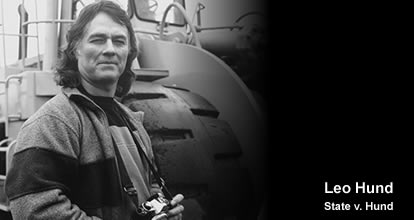
Faces of Liberty: The Right to Protest

"The right of the people to be secure in their persons...against unreasonable...seizures, shall not be violated, and no warrants shall issue but upon probable cause..."- Fourth Amendment, Constitution of the United States.
It was July 1984. Environmental activists spearheaded by the Cathedral Forest Action Group (CFAG) had been confronting loggers almost weekly since May in sit-downs and other protests aimed at saving one of the biggest remaining stands of old-growth forest in the Middle Santiam.
Leo Hund, then 33, was both an activist and a freelance photographer. He had been involved in similar protests in northern California and Oregon since his return from a trip through China several years earlier. He was shocked by the destructive clear-cutting practices he saw there.
"My first civil disobedience arrest was in the Sinkyone Wilderness in California in '82. These big redwoods run right up the valley from the ocean. The 55 trees they got that day were the only ones that got killed. Now it's a wilderness and it's safe."
Hund was arrested several times in the Middle Santiam that spring along with other CFAG members. But he was a journalist, not a protester, when Linn County sheriff's deputies in mid-July manhandled a group of sit-down strikers who were blocking log trucks at a bridge across Pyramid Creek.
"They cleared out the television cameras and reporters. Then they took guys by their beards and girls by their pony tails and dragged them maybe 200 yards from the bridge down to the vans. I stood there in the trees and squeezed off the pictures and got them to Eugene in time for the 5 o'clock Eyewitness News...The sheriff denied any of this happened. But I had pictures of it that got on the wire and went around the world. So they had big egg on their face."
When the protesters blockaded the Pyramid Creek bridge the following week, sheriff's deputies had something new up their sleeves — and an eye out for Leo Hund.
"One of them said: 'Well, Leo, we've got a surprise for you today. We're gonna take the pictures and you're gonna make the arrests.' I thought they were kidding. And I shouted: 'Okay, everybody's under arrest.' Then one deputy read me the language from the Riot Act they found. He said: 'You must physically subdue and arrest these people and put them in that van.' And I said: 'Well, they're not standing and I'm certainly not going to drag them down the bridge, so I don't think we have a deal.'"
When Hund refused the deputy's order, he was arrested for violating an Oregon statute that had lain dormant on the books since territorial days. It authorized police to order bystanders at "unlawful or riotous assemblages" to aid in arresting those who fail to disperse when ordered. It carried a maximum penalty of five years in prison and a $100,000 fine. Since there were scores of law enforcement officials on the scene that day and just four people blocking the bridge, there never was a question Hund's assistance was needed.
"One poor deputy later told the truth. He said: 'We met every day that week. We sat there with the book and actually planned to get you.' They had conspired for a week to get me at any cost and they had found that law."
The ACLU of Oregon came to Hund's defense.
The charges against him ultimately were dropped. Hund and two others who were arrested that day for the same violation filed a civil suit against Linn County in federal court, which was resolved in a settlement between the parties. In 1986, U.S. District Judge Edward Leavy issued an order holding "the riot act" unconstitutional on grounds that it violated the First, Fourth and Fourteenth Amendments of the U.S. Constitution. Most of the offending elements of the statute were removed from the books in 1987.
Photographer: Brian Foulkes
Writer: Harry Lenhart
Stay Informed
Sign up to be the first to hear about how to take action.
By completing this form, I agree to receive occasional emails per the terms of the ACLU’s privacy statement.
By completing this form, I agree to receive occasional emails per the terms of the ACLU’s privacy statement.
